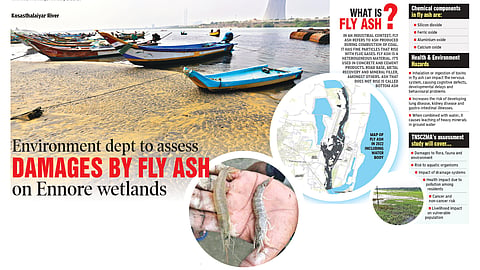

CHENNAI: Finally, a ray of hope for the environmentalists and fishermen, who had been demanding the government to take measures to remove fly ash accumulation on Kosasthalaiyar River in Ennore, as the Tamil Nadu State Coastal Zone Management Authority (TNSCZMA) has decided to assess the damages caused by the fly ash and devise an eco-restoration plan to Ennore wetlands.
According to a TNSCZMA document, a detailed project report (DPR) will be prepared to remove the ash completely, and also remediate and restore the land, wetlands, including main channel of Kosasthalaiyar River, its backwaters, riparian wetlands such as salt marshes, salt pans, mangroves and the tidal mudflats that are affected by coal ash from North Chennai Thermal Power Station (Stage-1 and Stage-2).
The project will also restore ecological and hydraulic integrity of the wetlands of Kosasthalaiyar River and Ennore.
During the assessment, a private consultant, who will be appointed by the TNSCZMA, will assess damages to livelihood and health of the exposed population apart from damages to the environment, and estimate compensation. It’ll prepare a plan for post-remediation monitoring with community involvement.
Also, a proposal will be prepared to strengthen technical and regulatory measures to prevent future contamination due to ash handling for thermal power plants in Ennore region.
The assessment area will cover area along the ash pipeline alignment to the west of ash dyke, area between coal yard and the eastern bund of the dyke and all wetlands (including floodplains, river channel, salt pans, salt marshes and mangroves). For assessing health impact, the study area has been defined as area falling within 5 km of boundaries of the study areas.
A few weeks ago, local fishermen released a people’s plan for eco-restoration of Kosasthalaiyar and Ennore Creek and urged the government to utilise their traditional knowledge while carrying out any remediation works. As per the ‘People’s Plan’, the government should remove the entire extent of fly ash as mapped by the expert committee appointed by National Green Tribunal (NGT) and transport it out so that the affected area can be restored as wetland and traditional fish ponds.
In another development, the Tamil Nadu Pollution Control Board (TNPCB) has invited consultants to study the carrying capacity study for Ennore and Manali regions, as the regions are worst-affected due to emission from industries including North Chennai Thermal Power Stations.
K Raju of Save Ennore Creek Campaign pointed out that the study is being initiated following an order from the NGT. “People of the locality want the government to include them while conducting the assessment and preparing restoration plans,” he added.
It may be recalled that based on NGT directions, a joint expert committee was formed to study the damages caused by fly ash in Ennore. The committee submitted a report in March 2022, based on which the Tribunal ordered the environment department to access and prepare plans for restoration.
As per the report, the total area with fly ash deposition is approximately 3.51 sq. km, which is nearly 28% of the bounds of the total study area selected for this analysis. The total area of fly ash deposition in the Kosasthalaiyar river is 1.51 sq. km.
The total volume of fly ash deposition in the study area is 39,83,002 cubic metres (around 5.67 million metric tonnes) of which 19,11,830 cubic metres (around. 2.67 million metric tonnes) are present in the backwater and the remaining in the flood plains.
Meanwhile, the Water Resources Department (WRD) has been studying Ennore wetlands to carry out the overall restoration works. “Once the WRD completes its study and submits a DPR, restoration works will be carried out along with Tamil Nadu Wetlands Mission. The fly ash study initiated by the Coastal Zone Management Authority is a separate study,” an official said.
Visit news.dtnext.in to explore our interactive epaper!
Download the DT Next app for more exciting features!
Click here for iOS
Click here for Android